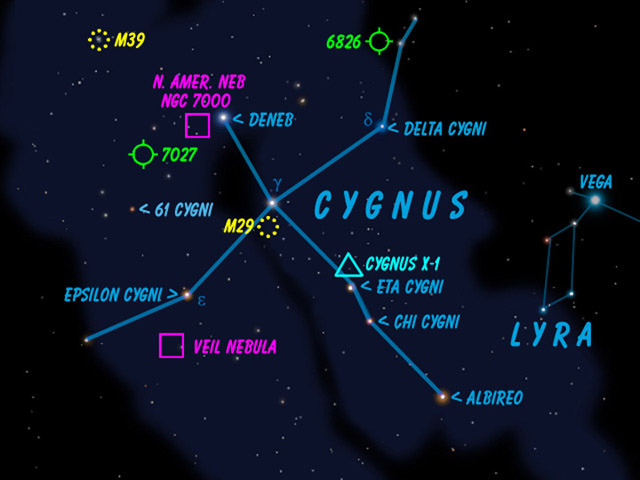
Featured Constellations |

|
|
|
Cygnus the swan is just one of the three
constellations that make up the "summer
triangle" - also included are Lyra the Lyre
(no, not a US. president, it's a primitive harp)
and Aquila the Eagle, each with their own first
magnitude star to mark them (Vega and Altair
respectively). Cygnus's number one luminary,
Deneb, is visually slightly fainter than the
other two, but it's still "first magnitude" (in
the top 25). Many other stars in Cygnus are
naked-eye bright, making the cross pattern of
the swan easy to spot high overhead on early
fall evenings.
|
|

Cygnus has long been associated with a bird, but not always a swan. Sometimes, it was seen as an eagle (like Aquila still is), or more importantly a hen. The ancient Arabs, who named most of the stars, gave "the hen" stars simple names like Dhanab al Dajajah (tail of the hen) that were partly passed down; that's how Deneb got its name. The formal swam pattern of today keeps the tail star at the tail - the long body of the bird flies south, with Albireo marking its nose. Sadr, at the bird's heart, is flanked by delta and epsilon Cygni, marking the beginnings of graceful wings spreading to east and west. In the middle ages, Christian-minded folks saw these stars as a giant cross in the sky, and some folks still refer to Cygnus as the Northern Cross (don't bother asking about the southern one, you can only see that from the southern hemisphere). Deneb does better as part of the cross - now it marks the top; in the Swan, it's "tail end Charlie".
Some of the richest parts of the milky way - the glow of billions of stars in our galaxy - pass right through Cygnus, and a pair of binoculars will show swarms of stars especially a little northeast of Deneb. Photographers might want to try a few long exposures near Sadr, in central Cygnus - the area is swirled with gas cloud nebulae. There's plenty to see in the swan. For a chart of selected highlights, click on "deep space objects".
|
|
|
|
| Home | Constellations | Deep Sky Objects |